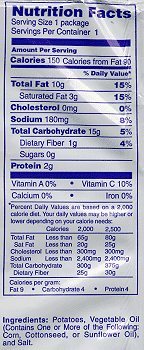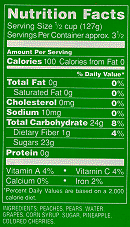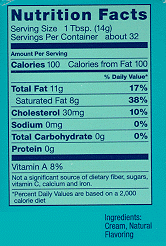

Mystery Food Labels
Mystery Label 1
Mstery Label 2
Mystery 3
|
Before the next commercial break, describe a food label. "What's a food label?" you may ask. When was the last time you read one while grocery shopping? I know, you don't shop for groceries. Parents shop for groceries. You simply go to the refrigerator or cupboard and grab whatever looks tasty. That's okay, but you will need to know about nutrition which leads to this FoodQuest/WebQuest. The purpose of this WebQuest is to introduce you to the Food Guide Pyramid and food labels. At the conclusion of this WebQuest you will be able to explain the items that are contained on a food label and their significance. You will also be able to plan a balanced meal based on the Food Guide Pyramid. Your task is to examine food labels for nutritional content and classify them according to the Food Guide Pyramid. You will also plan a menu. Your final project will include: A list of items from five different food labels Answer the Skill Level and Concept Level questions while you are on your FoodQuest. Skill Level
You will be working in teams. Think of a team name that relates to nutrition like the Macaroni Marvels or Rhubarb Raptors. 1. Examine 5 different food labels. Use the Websites in the FoodQuest for Health article.
When you read food labels you may have been surprised by what you found. You learned how the Food Guide Pyramid can help you choose daily servings from the food groups. Hopefully, you have learned the importance of eating well-balanced nutritious meals. You might like to look at somefood labels (on the left) that do not have any identifying information and guess the product or prepare one of the meals you planned. Teacher Facilitated Extension Grocery Bag Bonanza Did you know that you can shop online and have groceries
delivered right to your doorstep without leaving the comfort of your home?
Take your students on a virtual shopping trip. Give your students a budget
and let them shop for a week's worth of groceries. Have them print their purchases
and total cost. Share the results of the excursion in class. What are the
advantages and disadvantages of shopping online? Why might a storeowner prefer
that you shop in person rather than electronically? NetGrocer is a site that
allows you a try out without a login and password. To place an actual order
you must have a membership. This is a great culminating activity or one that
can stand-alone.
YUM!
|
||||||||||||||||||||||||
|
|||||||||||||||||||||||||
© 1996 - 2017 Linda C. Joseph
All Rights Reserved
All CyberBee Graphics are Trademarked
Graphics by
Darlene Vanasco/Creative Director
Erika Taguchi/Designer & Illustrator
Hosting Provided by Iwaynet



